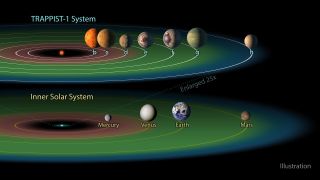SETI tests new alien-hunting strategy, but TRAPPIST-1 planets remain silent
Some 25 million radio signals were detected, but all were eliminated by a clever computer code as terrestrial radio frequency interference.

The latest hunt for alien signals in the TRAPPIST-1 planetary system has test-driven a new strategy that will allow astronomers to perform a more efficient, targeted search for technological extraterrestrial life in the future.
TRAPPIST-1 is a multi-planet system about 40.7 light-years away. Its seven rocky worlds, some of which lie in the habitable zone — the zone around a star where it isn't too hot nor too cold for a planet to host liquid water — are all bunched up so tightly that they transit their star every few days. The number of planets and their relative proximity to us make the TRAPPIST-1 system a tantalizing target for the search for extraterrestrial intelligence (SETI).
Although this latest search — in which the Allen Telescope Array of radio telescopes in California spent 28 hours in total listening to TRAPPIST-1 — did not detect any alien signals, "the point of the study was to demonstrate a more efficient search strategy, utilizing the natural orbital configuration of an edge-on multi-planet system to our advantage," Nicholas Tusay, a graduate student at Penn State University, told Space.com.
Traditionally, SETI has scanned the sky in search of powerful signals directed at us. However, after decades of not finding anything, SETI researchers are increasingly considering other strategies. These include searching for radio leakage: incidental transmissions not intended for us, but which might leak out from a planetary system. Such transmissions could range from communications and spacecraft emissions to radar or even the equivalent of alien TV. However, because this incidental leakage would not be transmitted with the intention of being heard light-years away, it would likely be of much lower power than deliberate signals would be.
The likelihood of us spotting such leakage by chance would thus be slim, so we need strategies that can improve the odds.
To this end, Tusay led the observations of TRAPPIST-1, which took advantage of a phenomenon called planet–planet occultations (PPOs). An occultation occurs when one object in the sky appears to move in front of another. As the seven TRAPPIST-1 planets orbit in a plane around their star that is almost perfectly edge-on to us, we can witness many PPOs, where effectively the two planets involved in the PPO and our detectors are all in a direct line.
Related: How AI is helping us search the universe for alien technosignatures
Get the Space.com Newsletter
Breaking space news, the latest updates on rocket launches, skywatching events and more!
Now suppose that transmissions from the planet being occulted are directed at the planet doing the occulting. These transmissions might be communications similar to those from NASA's Deep Space Network (DSN), in which large radio transmitters in Canberra, Madrid and California keep in constant touch with our fleet of interplanetary spacecraft. Similarly, it is possible that during a PPO, when two planets and ourselves are in a line, we could pick up leakage from radio transmissions between the two planets from the alien equivalent of the Deep Space Network. That's what this latest survey of TRAPPIST-1 was hunting for.

"TRAPPIST-1 is the ideal laboratory because it has known transiting planets, nearly perfectly edge-on, and it’s so close that we have enough sensitivity to detect certain signals," said Tusay.
No signals were detected, but we needn’t be downhearted.
That's because the Allen Telescope Array is only sensitive enough to detect interplanetary transmissions at TRAPPIST-1 that are being broadcast with a power equivalent to an Arecibo-sized transmitter. Before it collapsed in 2020, the Arecibo radio telescope was a 305-meter (1,000-foot) dish. However, a powerful transmitter such as Arecibo would be “overkill” for interplanetary communications, said Tusay. The telescopes of the DSN are smaller in comparison with a lower effective power — too low for the Allen Telescope Array to detect. However, when it begins science operations towards the end of this decade, the Square Kilometer Array in South Africa and Australia should have the sensitivity to detect DSN-level transmissions during PPO events.
The Allen Telescope Array experiment has now shown that this PPO method is feasible. The ATA observed seven PPO events during the 28 hours it spent gazing at TRAPPIST-1 in 2022. In total it detected 25 million radio signals during that time.
"Most of that is radio frequency interference (RFI) from our own communications, so we needed to filter that out," said Tusay.

Radio frequency interference (RFI) is the terrestrial background of radio signals on Earth, from mobile phones to airport radar. In order to remove RFI from the observations more easily, Tusay developed something called the NBeamAnalysis pipeline. It is computer code that is able to distinguish signals that come only from the target, in this case TRAPPIST-1, from RFI that is seen in other directions in the telescope's field of view. By doing so, the code was able to whittle the 25 million signals down to just 2,264 that required further attention from a human being.
"Instead of looking through tens of millions of hits by eye, I only have to look through a few thousand, and most of them are still obvious to the human eye as RFI," said Tusay.
Ultimately, all the detected signals during the TRAPPIST-1 observations were RFI, but there are reasons why the Allen Telescope Array should keep looking. Although we can only guess as to the nature of an alien communication system and how often non-Earth beings would communicate with neighboring planets, comparing their signals to our own Deep Space Network is a starting point. Tusay's team estimates that the DSN is transmitting to Mars about a third of the time, meaning, on average, aliens would have to watch three PPO events of Earth and Mars to spot us sending a signal to one of our spacecraft around the Red Planet. If aliens are following a similar cadence at TRAPPIST-1, we'd have to watch at least three PPO events of each combination of planets to stand the best chance of spotting them.
This raises a question: Could aliens be watching for PPOs of planets in our own solar system? Those would happen more infrequently than in the TRAPPIST-1 system, where the planets are so close to their star that they orbit in a matter of a few days. Conversely, PPOs of Earth and Mars would take place approximately once every two years. In order to see a PPO of Earth and Mars, aliens would also have to be on a planet orbiting a star that is in the ecliptic on the sky, because the ecliptic is the plane of our solar system, and only by seeing this plane edge-on would they see any transits or occultations.
Nevertheless, "I know that searching for evidence that our own DSN transmissions have been picked up is an active area of investigation by other SETI scientists,” said Tusay. "I personally think that search strategy has merits."
In the meantime, we must keep listening to the sky — and thanks to these new observations of TRAPPIST-1, we at least now have a better idea of the best times during which to listen.
The findings are described in a paper that has been accepted for publication in The Astronomical Journal, and there is a pre-print available on arXiv.
Join our Space Forums to keep talking space on the latest missions, night sky and more! And if you have a news tip, correction or comment, let us know at: community@space.com.

Keith Cooper is a freelance science journalist and editor in the United Kingdom, and has a degree in physics and astrophysics from the University of Manchester. He's the author of "The Contact Paradox: Challenging Our Assumptions in the Search for Extraterrestrial Intelligence" (Bloomsbury Sigma, 2020) and has written articles on astronomy, space, physics and astrobiology for a multitude of magazines and websites.
-
ChrisA We are actually learning quite a lot from SETI. We now know there is no galactic Internet-like radio network. We know that no one is trying to contact us and we know that technological civilizations, if they exist at all are very rare. 100 years ago we did not know these things.Reply
Or it might be that very advanced civilizations do not waste power by radiating signals out into space. I would bet they are VERY efficient and power simply does not escape its intended purpose which means we will never detect them until they decide to send a signal our way. -
Helio The Trappist system has an M8V type star as the host. Red dwarfs are known for temper tantrums (large flares, etc.). The HZ here is only ~0.03 AU, so. IMO, such systems are unlikely places to find sentient life.Reply -
Joexo ReplyChrisA said:We are actually learning quite a lot from SETI. We now know there is no galactic Internet-like radio network. We know that no one is trying to contact us and we know that technological civilizations, if they exist at all are very rare. 100 years ago we did not know these things.
Are we trying to contact someone specifically? Maybe the aliens in Trappist, if they exist, are just like us with their own SETI version, looking for aliens trying to get in touch with them.
It would be hilarious if we're surrounded by aliens and we all think the other should make the first move, and we're all just passively listening. -
billslugg We are not, on a large scale, actively trying to communicate with extra terrestrial civilizations, however our military radars are doing that unintentionally. Our commercial TV/radio signals drop below the Sun's noise level before they get to Jupiter. We are putting a lot of effort into detecting artificial signals but so far, nothing repeatable. There could well be a galactic internet. One cannot prove the non-existance of something.Reply -
Joexo Reply
this is exactly what I'm saying. Likely aliens are doing the same.billslugg said:We are not, on a large scale, actively trying to communicate with extra terrestrial civilizations, however our military radars are doing that unintentionally. Our commercial TV/radio signals drop below the Sun's noise level before they get to Jupiter.
Unless some alien world is directly pointing a message at us we won't detect it.
Why should we expect than an alien civilization would spend resources to point a super strong message directly towards earth for decades until we discover them?
I think it's nonsense to expect this.
I don't know the monetary interests behind SETI but I think that's the only thing happening there.
Them pointing their radars at Trappist and hearing nothing only proves that the aliens over there, if they exist, probably have better problems or things to do with their time then pointing messages at earth. -
billslugg Planets from far away would first see that Earth had fluorocarbons in its atmosphere, thus would know intelligent life existed here. Then they would beam a signal directly at us.Reply
SETI is entirely privately funded and is operated by volunteers. -
Unclear Engineer I think that Bill is right that if an extraterrestrial technological civilization was out there in a similar state of development and curiosity as we are today, they would be looking at nearby stars for planets and trying to detect traces of technological development in the atmospheres of planets that seem to them to be "habitable".Reply
But, once they found one (us?), would they decide to send a signal to what they think is another technological civilization? Would (will) we, in the same situation? Would we be able to stop "ourselves" (meaning unauthorized rogue communicators).
I would not be at all surprised if there is such a planet, somewhere, even right now. But, it is the combination of "right now" and "nearby" that seems to have a strong probability of being zero cases. Even if technological civilizations develop on other planets with a high probability, they would have to last a long time in order for there to be a high probability of one to find and be close enough to communicate with us during our own period of possibility, so far. -
Joexo Reply
@Unclear Engineer, I admire your way of expressing your ideas with such clarity.Unclear Engineer said:I would not be at all surprised if there is such a planet, somewhere, even right now. But, it is the combination of "right now" and "nearby" that seems to have a strong probability of being zero cases. Even if technological civilizations develop on other planets with a high probability, they would have to last a long time in order for there to be a high probability of one to find and be close enough to communicate with us during our own period of possibility, so far.
I don't like the misinformation narratives behind SETI, as the media outlets make it sound like there's no intelligent alien life anywhere because SETI hasn't found it in 50 years.
But its very possible that it's all around us, but they're simply not pointing any beams at us, SETI should be called: SETIPBAU (search for extra terrestrial intelligence pointing beams at us). -
Mike Everman So the premise is that the folks in the Trappist system are either multi-planetary (more advanced than us, talking planet to planet), or communicating with spacecraft orbiting other planets (like us). In the first case, transmitter power is planetary size (and we have to assume less than an Arecebo sized transmitter, because, how impractical is that?) In the second case, we would only get half of the possible near-occlusion spillover events, because it is unlikely that a small spacecraft like we might have will have planetary sized transmission power, and so we only really have a chance at the planetary scale transmissions.Reply
We humans are not too far away from relying solely on laser optical communication links (especially with interplanetary spacecraft), precisely because of the inefficiency of RF transmissions, and how much lower frequencies spread and attenuate with distance.
I find it unlikely to imagine that our extraterrestrial friends will not also be using directed energy in tighter beams, with higher frequency optical bands which are capable of higher data rates and distance with less power. I fear that while the direction seems good, we are listening to the wrong bands, and must assume that they, like us, are about done with RF.
JWST is more likely to pick up what they are saying, if anything, in infrared.
https://www.nasa.gov/communicating-with-missions/lasercomms/ -
Unclear Engineer Trappist 1's planets don't really seem like they would have a high probability of evolving or sustaining life. They are very close to a very cool star, and are not even known to have atmospheres at this point in our research. And, they are expected to be tidally locked. So, even if they are much older than Earth, there isn't much reason to think they are much like Earth, or that some technological society would develop there, or if it had, that it would have lasted long enough to be concurrent with ours.Reply
And, given that it is 40 light years away, if it did have a technological society that was looking for technological societies like us, it would have had to discover what we were 80 years ago (and acted quickly) to get a signal off to us in response that we would just be getting now.
All of that seems so unlikely that not finding any signals coming from those planets now seems to be of near zero value for concluding that there is nothing out there at all in the way of other technological societies on planets around other stars, elsewhere.
But, it does seem like a good place to test our SETI techniques.